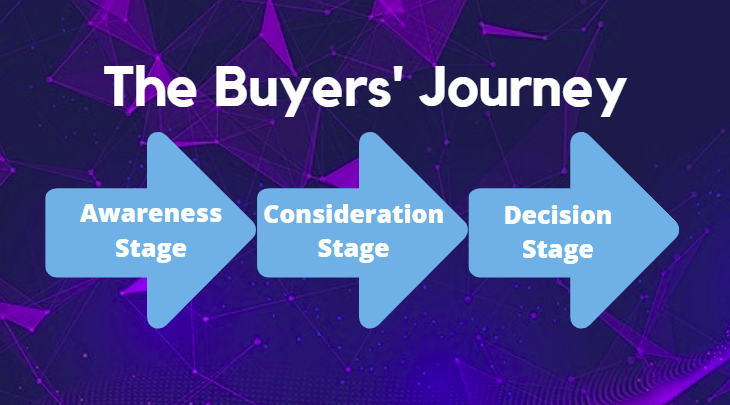Outbound lead generation (cold calling, etc) is a great way for business-to-business companies to fill their sales pipelines, particularly where there are large deal sizes involved. You can be very intentional about the types of companies you target. If you arm your Sales Development Representatives with a good script, the right target personas, and accurate contact data, they can get you into many conversations with prospects that will need a product or service like yours in the future.
But will these opportunities impact your quota this quarter, next quarter, or sometime in the next 12 months? Specific timing depends on your industry’s normal sales cycles, as well as where your prospect is in their Buyer’s Journey. The Buyer’s Journey has three stages: Awareness, Consideration, and Decision. There are pluses and minuses to connecting with prospects in each stage.
The Awareness Stage
 A Prospect in the Awareness Stage may only have just figured out that they have a problem in the area that you are able to solve (Ex: “We need to improve our data and analytics capabilities.”)
A Prospect in the Awareness Stage may only have just figured out that they have a problem in the area that you are able to solve (Ex: “We need to improve our data and analytics capabilities.”)
Often appointments with these prospects will start off introductory in nature. You can establish a relationship early on, helping the prospect better define their problem, and begin to shape their concept of the solution. If you do a good job nurturing this type of prospect, when the time comes to buy, they might not shop around very much or might skip putting out a formal Request For Proposal (RFP) (assuming their organization allows for that). If they must put out an RFP, the ideas you get in front of them early will influence the questions they ask you and your competitors. This scenario may have a longer sales cycle, but a large deal where you have a running start on the competition is a beautiful thing.
The Consideration Stage
 In the Consideration Stage, the prospect has a clearly defined need and is researching different ways to solve their problem (ie, “we believe Product X is probably the right tool to improve our data and analytics capabilities, but how will we implement and support it?”).
In the Consideration Stage, the prospect has a clearly defined need and is researching different ways to solve their problem (ie, “we believe Product X is probably the right tool to improve our data and analytics capabilities, but how will we implement and support it?”).
If your SDR gets you an appointment with this type of prospect, you may still be engaged early enough to influence the vision of the solution to the problem they have defined. You may still be able to build enough comfort to minimize a competitive process. This type of prospect could impact your number in the medium term. This is arguably the most desirable phase in which to connect with a prospect, but the window of time a prospect spends here can be relatively narrow.
The Decision Stage
 A Prospect in the Decision Stage has already formulated their idea of both the problem and the solution (ie, “We are going with Product X and will outsource the implementation and support, so we are taking bids from companies that implement and support Product X.”).
A Prospect in the Decision Stage has already formulated their idea of both the problem and the solution (ie, “We are going with Product X and will outsource the implementation and support, so we are taking bids from companies that implement and support Product X.”).
They are looking for you to fit into their vision rather than allowing you the opportunity to significantly shape what their vision of the solution looks like. They may be ready to issue an RFP that you can bid on or may less formally start taking bids from multiple competitors. While this deal could impact your number in the near term, you are going to have more of a competitive fight on your hands to win the deal. You might get a quick win, or you might end up as just another column in the buyer’s spreadsheet, aka “column fodder.”
Meet Prospects Where They Are In Their Buyer’s Journey
The sense that Outbound has longer sales cycles is partially a function of it being more likely to connect sellers with prospects that are in the Awareness Stage than many other marketing channels would. Marketing channels that depend on the prospect to already be investigating solutions are likely to catch people in the Consideration or Decision Stages. Outbound will get you all three, so that can lead to a longer average sales cycle among outbound deals compared to other opportunities. That said, you can win deals with prospects that you first engage in any of the three phases, as long as you are willing to adapt your sales approach to meet them where they are in their buying process.
If your deal sizes are small, you might not have the luxury of nurturing prospects over a longer period of time. However, on larger deal sizes, getting in early and helping the buyer shape their vision of the problem as well as the solution can help lay the foundation for a mutually beneficial long-term relationship … and help you retire serious chunks of quota.


